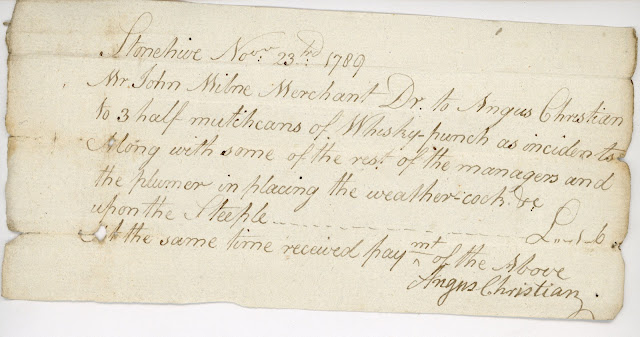Should I keep my receipts? Archives, appraisal and 18th century Stonehaven
I have a bit of a reputation within the archive team of being anti-receipt. There are sound reasons for my prejudice: they take up a lot of space in relation to the quality of information they provide, and this information is typically duplicated in other financial records if they survive (such as cash books, journals and ledgers). They also take a lot of time to list individually, but conversely if they aren't listed individually, they won't get used very often.
There are two notable exceptions to my anti-receipt stance: one is receipted bills with illustrated letterheads, which can provide lots of information about the company sending the bill and are often visually valuable. You can see an example of this type of thing in these Facebook posts (and here).
The second exception is early receipts where other financial records haven't survived. These receipts can provide financial detail on local business that would otherwise not have been recorded. It is these that I'm going to focus on today, discussing a collection of receipts and other papers within the Stonehaven Burgh collection. I have focused on six bundles of mainly 18th century financial records and legal papers, totalling over 650 items (catalogue entry here).
First up is a receipt relating to public health and the operations of the harbour. It details the costs of removing a dead horse from the harbour in 1792. Although unpleasant, it would be more unpleasant if the horse had been left as a 'public nuisance'!
The concern about privateers continued into the following month, when the town's feuars petitioned the Sheriff of Kincardine to form a guard for the town and harbour after reports of two French Privateers on the coast, one of which had taken a ship from Montrose.
Three soldiers from the 90th Regiment of Foot were given five shillings in 1802 to allow them to travel to rejoin their regiment at Aberdeen after becoming ill in Stonehaven. They signed the receipt with their marks indicating that they were illiterate.
There are also receipts for payments to the poor, including a list of poor which notes the various payments issued in 1751:
The town's managers appear to have enjoyed a drink at many of their meetings. There are several receipted bills from local hostelries, including the George Inn:
There is also a bill for the town's festivities after the Earl Marischal, the town's feudal superior, returned to Scotland in 1760. As a burgh of barony, Stonehaven was erected by a charter granted to the Earl Marischal rather than to the burgh itself (as was the case in burghs like Aberdeen or Banff) and the superior had a lot of control over the burgh. The 10th Earl Marischal, George Keith, forfeit his estates after the 1715 Jacobite uprising and he fled to Europe (the superiority passed to the York Building Company). The celebrations for his return in 1760 appear to have been raucous as the bill includes the cost of several broken wine glasses. (For more information about Stonehaven's relationship with it's feudal superior see our former colleague Ruaraidh Wishart's article in Scottish Archives).
Drink was also purchased on the completion of projects, like the work on the town's steeple in 1789, where 3 half mutchcans (a measure equivalent to a quarter of a pint) of whisky punch was bought.
As well as receipts, the bundles include legal papers and petitions received by the town's manager. Below is petition dated 1760 from the town's inhabitants about the timing of allowing cows onto the commons. It has been signed by twelve locals (including three women).
To finish up, a couple of unusual items: below is a printed order from Customs officials in Edinburgh in 1751, ordering all Scottish ports to prevent a Dutch ship, the Ruygen Hoff, from making port as it had plague on board.
And finally, a bill for garden seeds purchased by William Stewart, a lawyer in Edinburgh, from Robert McLellan. The seeds were for William Herdman, a merchant in Stonehaven who was one of the town's managers in the 1740s.

Katy Kavanagh, Senior Archivist.














Comments
Post a Comment